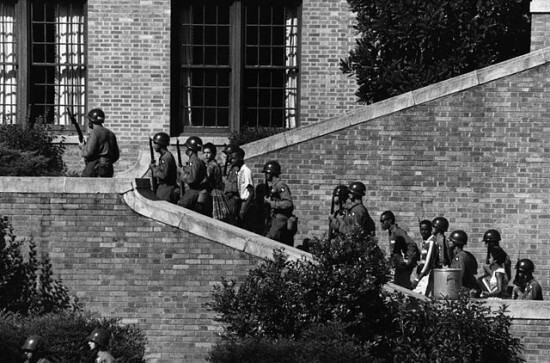
Once this happened there were many blacks who tried to register for school in what had previously been all-white schools. The National Association for the Advancement of Colored People (NAACP) were behind the efforts to register black students in previously all-white schools in cities throughout the South.
One of these cities was Little Rock, the capital city of Arkansas. The school board in Little Rock had already decided to comply with the Supreme Court ruling, and had a plan for gradual integration. The plan was supposed to be implemented in 1958. However, the NAACP had registered nine black students to attend Little Rock Central High in 1957. This school had previously been all-white. The nine students registered at this school had been selected to go there based on their grades and their attendance, both of which were excellent.
So what happened was the day these nine students were supposed to start school in this newly segregated school, several citizens threatened to hold protests and block the students from entering the building. The governor at the time, Governor Orval Faubus, deployed the Arkansas National Guard to support these citizens. This happened on September 4, 1957. The sight of a line of soldiers blocking nine black students from attending high school made national headlines and polarized the city.
The problem began to escalate and on September 9, “The Council of Church Women” issued a statement condemning the governor’s deployment of soldiers to the high school. In this statement they called for a citywide prayer service to be held on September 12.
Soon the escalation was so great that even President Dwight Eisenhower attempted to de-escalate the situation. He talked to Governor Faubus and warned him not to interfere with the Supreme Court’s ruling.
This led to an injunction that ordered the Governor to withdraw the National Guard. This was done September 20th.
Then, members of the 101st US-Airborne Division escorted the “Little Rock Nine” (those nine students) to school. At this point the governor backed down and let the local police handle the situation.
However, the situation was far from over. There were still hundreds of protesters, mostly parents of the white students at the school, still standing in front of the school. On Monday, September 23, the police slipped the nine students into the school without detection. However, when the protesters found out that the nine black students were inside the school they confronted the line of policemen. The police were far outnumbered, and in fear of a riot, they escorted those nine students out of the school.
This led to the President needing to step in again. The mayor of Little Rock had to ask President Eisenhower to send federal troops to enforce integration and protect the nine students. So, once again, on September 24, the President ordered the 101st Airborne Division of the United States Army to Little Rock and federalized the entire 10,000 member Arkansas National Guard, taking it out of the hands of Governor Faubus. Then an ad hoc unit, Task Force 153rd Infantry, was put together. What ended up happening was the bulk of the Arkansas Guard was quickly discharged from federalized status, but Task Force 153rd Infantry remained federalized. They took over the entire operation and remained on duty until the end of the school year.
Despite all of these efforts, the citizens still protested and pressured the Little Rock School Board. Eventually the pressure was so great that they reversed their decision to integrate the schools, and in August 1958, with support from Governor Faubus and the Arkansas State Legislature, the school board canceled the entire 1959 school year for its three high schools rather than integrate them.
The result was that thousands of high school students left the city to attend high schools in other school districts.
A year later, federal court rulings and the Little Rock Chamber of Commerce pressured the school board into reopening the school system, and integrate. In fall of 1959, Little Rock public schools reopened as an integrated school system.
The Little Rock Nine were:
Ernest Green
Elizabeth Eckford
Jefferson Thomas
Terrence Roberts
Carlotta Walls Lanier
Minnijean Brown-Trickey
Gloria Ray Karlmark
Thelma Mothershed-Wair
Melba Pattillo Beals

and muhammad ali suppose to go fight in vietnam when this is being done white people are such hypocrites
wassup james broadnax
just stupid info